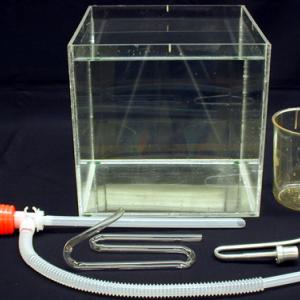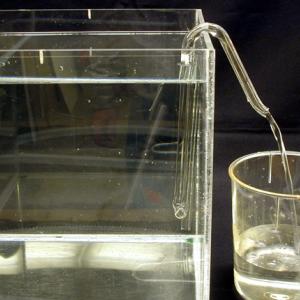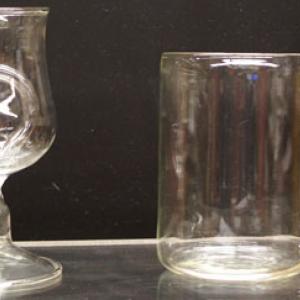College of Liberal Arts & Sciences
2B60.30 - Siphons, Self Starting Siphons, & Tantalus Cups
Video Credit: Jonathan M. Sullivan-Wood.
Fill the Plexiglas cube nearly to the top with water. The homemade glass and the Skimit siphons are self starting. Insert and hang these on the edge of the Plexiglas cube. The siphon flow will start automatically.
The bulb siphon uses vacuum to draw the liquid up into the tube. The bulb may have to be squeezed several times to get the liquid to the proper height.
The Tantalus or Pythagorean cups are nothing more than self starting siphons. Very cool but watch out, you will get wet if you aren't careful!!
We have a variety of relaxation oscillators available. Look at these webpages:
3A95.10 - Relaxation Oscillators
6-00.00 - Stroboscope (we have small variable frequency strobe lights available).
2B60.30 - Tantalus Cups
3D32.15 - Stadium Horn
4C30.25 - Geyser
4C31.30 - Drinking Bird
4C31.37 - Franklin's Pulse Glass Engine
5A40.70 - Kelvin Water Dropper
5F30.60 - Relaxation Oscillators - Neon Bulb, Doorbell, and Strobe Lights
10A06.10 - Relaxation Oscillators
13A10.10 - Perpetual Motion
- William Jumper and Simthyrearch Dy, "What the CO2 Siphon Tells Us", TPT, Vol. 56, #6, Sept. 2018, p. 373.
- William D. Jumper and Boris Stanchev, "Towards Explaining the Water Siphon", TPT, Vol. 52, #8, Nov. 2014, p. 474.
- Alex Richert and P. -M. Binder, "Siphons, Revisited", TPT, Vol. 49, #2, Feb. 2011, p. 78.
- Martin Gardner, "Physics Trick of the Month: Mysterious Siphon", TPT, Vol. 39, #9, Dec. 2001, p. 561.
- Paul Chagnon, "Animated Displays V: Relaxation Oscillators", TPT, Vol. 32, # 7, p. 432- 436, Oct. 1994.
- Raymond E. Benenson, "The Hyphenated Siphon", TPT, Vol. 29, #3, Mar. 1991, p. 188.
- Henry S. Badeer and James W. Hick, "Role of Viscous Resistance in Siphon Flow", TPT, Vol. 28, #8, Nov. 1990, p. 558.
- R. D. Edge, "String & Sticky Tape Experiments: A Siphon Demonstration", TPT, Vol. 26, #2, Feb. 1988, p. 114.
- E. J. Ansaldo, "On Bernoulli, Torricelli, and the Syphon", TPT, Vol. 20, #4, Apr. 1982, p. 243.
- Thomas B. Greenslade, Jr., "A Potpourri of Siphons", TPT, Vol. 15, #7, Oct. 1977, p. 425.
- Thomas B. Greenslade, Jr., "Dribble Glasses (Photo)", AJP, Vol. 78, #6, June 2010, p. 615.
- Thomas B. Greenslade, Jr., "Tantalus' Cup (Photo)", AJP, Vol. 71, #1, Jan. 2003, p. 45.
- James H. Vignos, "Comment on: Relaxation Oscillators: Electrical and Water", AJP, Vol. 40, #2, Feb. 1972, p. 360.
- Leonard Finegold, "Relaxation Oscillators: Electrical and Water, AJP, Vol. 39, #5, May 1971, p. 575.
- Glen Davidson, "Siphoning Off the Last Word", Physics Today, Vol. 64, #11, Nov. 2011, p. 10.
- Arthur G. Schmidt, "Siphon Uses Atmospheric Pressure", Physics Today, Vol. 64, #4, Apr. 2011 p. 11.
- Toni Feder, "Physicist Uncovers Dictionary Error", Physics Today, Vol. 63, #8, Aug. 2010, p. 28.
- Robert Ehrlich, "6.6, Maximum Height of a Siphon", Why Toast Lands Jelly-Side Down, p. 104.
- John Henry Pepper, "Pneumatics", Cyclopadic Science Simplified, p. 462.
- R. W. Pohl, "(3)", Physical Principles of Mechanics and Acoustics, p. 182.
- R. W. Pohl, "Relaxation Oscillations", Physical Principles of Mechanics and Acoustics, p. 228.
- Charles Vivian, "Make a Simple Siphon", Science Experiments & Amusements For Children, p. 45.
- Martin Gardner, "10, The Mysterious Siphon", Smart Science Tricks, p. 22.
- Martin Gardner, "Self-Starting Siphon", Entertaining Science Experiments with Everyday Objects, p. 112.
- Jearl Walker, "2.41, Siphons and Toilets", The Flying Circus of Physics Ed. 2, p. 99.
- Christopher P. Jargodzki and Franklin Potter. "107, The Siphon", Mad About Physics, p. 38, 182.
- Nail A. Downie, "16, A Symphony of Siphons", Vacuum Bazookas, Electric Rainbow Jelly, p. 134.
- Tik L. Liem, "The Self-Priming Siphon", Invitations to Science Inquiry - Supplement to 1st and 2nd Ed. p. 32.
- Francisco Vera, Rodrigo Rivera, Diego Romero-Maltrana, Jaime Villanueva, "Negative Pressures and the First Water Siphon Taller than 10.33 Meters", PLOS ONE, April 7, 2016.
- Joseph Frick, "#104 - The Siphon", Physical Technics: Or, Practical Instructions for Making Experiments in Physics and the Construction of Physical Apparatus with the Most Limited Means", p. 124.
- "Tantalus Cup", Pike's Illustrated Catalogue of Scientific & Medical Instruments, 1984, p. 232.
- The Queen Catalogues Vol. II, Catalogue of Physical Instruments, No. 4204, p. 24.
- The Queen Catalogues Vol. II, Catalogue of Physical Instruments, No. 4209, p. 24.
Disclaimer: These demonstrations are provided only for illustrative use by persons affiliated with The University of Iowa and only under the direction of a trained instructor or physicist. The University of Iowa is not responsible for demonstrations performed by those using their own equipment or who choose to use this reference material for their own purpose. The demonstrations included here are within the public domain and can be found in materials contained in libraries, bookstores, and through electronic sources. Performing all or any portion of any of these demonstrations, with or without revisions not depicted here entails inherent risks. These risks include, without limitation, bodily injury (and possibly death), including risks to health that may be temporary or permanent and that may exacerbate a pre-existing medical condition; and property loss or damage. Anyone performing any part of these demonstrations, even with revisions, knowingly and voluntarily assumes all risks associated with them.


